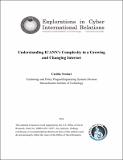| dc.contributor.author | Testart, Cecilia | |
| dc.date.accessioned | 2022-04-06T11:41:33Z | |
| dc.date.available | 2022-04-06T11:41:33Z | |
| dc.date.issued | 2014 | |
| dc.identifier.uri | https://hdl.handle.net/1721.1/141699 | |
| dc.description.abstract | The ever-increasing relevance of the Internet in all aspects of our lives has significantly raised the interest of cyberspace in the political, economical and international spheres. Internet governance and its future design are now relevant to many different stakeholders eager to influence and engage in the decision and policy-making processes. The Internet Corporations for Assigned Names and Numbers (ICANN) is recognized as the central institution involved in the governance of the global Internet. Specifically, it is in charge of the allocation, coordination and development of policy relating to the critical Internet resources –Internet Protocol addresses, Domain Names System and parameter numbers. It was created in 1998, when the Internet had less than 10% of the current Internet users and the World Wide Web potential was just emerging, and was expected to have a technical mandate. Over time, ICANN structure has evolved, resulting in a large and complex institution, with several internal bodies intermingled with its functions. Nonetheless, a very limited number of Internet users know what ICANN is or what ICANN does, because the Internet has always “just worked”. This paper contributes to the understanding of who participates in ICANN’s decision-making and policy-development processes and how. It first examines in details the internal structure of the organization, and then its structural and financial evolution and change since its early stage. The study is based on an in-depth analysis of the legal, financial and public documents of ICANN, as well as the information published directly by ICANN’s internal bodies. The paper reveals the substantial expansion in scale and scope of ICANN mandate and activities since its creation. ICANN recurring changes leading to the current complex structure and processes for policy development, allowed it to cope with and adapt to growth, evolution and change in the Internet and its usages. Additionally, these processes constitute an outreach mechanism for ICANN to its constituencies. However, the permanent internal restructuring, deter and hinder the follow up by external interested parties such as governments and international organizations, which are now requesting more involvement in policy-development processes concerning the Internet. | en_US |
| dc.description.sponsorship | This material is based on work supported by the U.S. Office of Naval Research, Grant No. N00014-09-1-0597. Any opinions, findings, conclusions or recommendations therein are those of the author(s) and do not necessarily reflect the views of the Office of Naval Research. | en_US |
| dc.language.iso | en_US | en_US |
| dc.publisher | © Massachusetts Institute of Technology | en_US |
| dc.relation.ispartofseries | ECIR Working Paper No. 2014-3 | |
| dc.rights | Attribution-NonCommercial-NoDerivs 3.0 United States | * |
| dc.rights.uri | http://creativecommons.org/licenses/by-nc-nd/3.0/us/ | * |
| dc.title | Understanding ICANN’s complexity in a growing and changing Internet | en_US |
| dc.type | Working Paper | en_US |
| dc.identifier.citation | Testart, C. (2014). Understanding ICANN’s complexity in a growing and changing Internet (ECIR Working Paper No. 2014-3). MIT Political Science Department. | en_US |
| dc.eprint.version | Author's final manuscript. | en_US |
